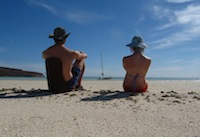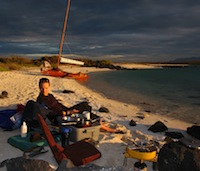Part 1
Part 2
Part 3
Part 4
Part 5
Part 6
Part 7
There are eight reasons for a Canoe Tri:
1st ~ To blend paddle and sail, because the water is a fascinating mix of wind and none. To do it without awkwardness, without wrestling a sail or shoving a paddle down among your other gear.
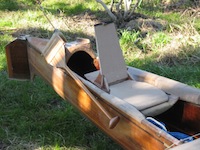
Start with the captain’s seat in the right place for both, so one sits high up and well braced to paddle yet has sail controls at one’s fingertips without moving. The paddle is in a “holster” just behind this seat. Quick-draw or re-holster in one quiet movement.
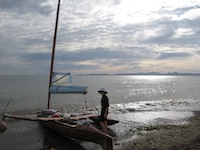
The mainsail is stored in a “lazybag” above sitting head height. It goes into action slower than a paddle but we claim to have made great improvement here.
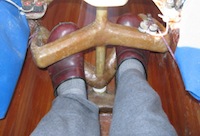
The boat is steered by both feet, leaving both hands free to paddle and control sail. Those feet have a good hold and brace on the steering rotor, giving those hands all their native power for many tasks.
2nd reason ~ To fit one person like a glove, yet have seats for five and room for lots of stuff, canoe-like.
The captain’s space is built to keep him in the boat,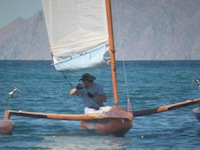 though he is sitting sort of on top and it’s only two feet
wide. He is supported at hip, thigh and calf and his
feet have strong purchase. He can lean far over the side
and still feel secure, without hands. The chair reclines
and has a head rest. A very personal boat
though he is sitting sort of on top and it’s only two feet
wide. He is supported at hip, thigh and calf and his
feet have strong purchase. He can lean far over the side
and still feel secure, without hands. The chair reclines
and has a head rest. A very personal boat
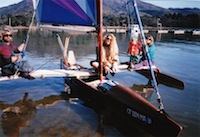
It has another character completely, to be able to fill up the crossarm with people. The mast holds up the ends of the light crossarm when it is stressed this way. The canoe will sail satisfyingly well with 800 lbs aboard, not including its own 200 lb weight.
3rd ~ Paddle at 4 knots AND sail in the low teens.
A slender boat with 17” high well-padded seats and precise foot-steering should be fun to paddle. 225 sq. ft. of sail on a 24 ft. mast should sail fast. Neither is noteworthy by itself, though. Doing both is, and fits the world.
4th reason ~ Sail well in 9 inches of water and take the ground without fuss.
Excellent above-water features allow very modest underwater wings.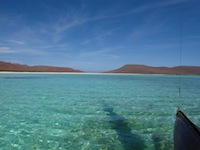 A 2 inch deep shoe keel (with a big radius at its root) runs most of
the length and the rudder is no deeper than this keel. The rudder is hung
behind a bulletproof skeg and has tough wings on its bottom that make it act
deeper and bear weight. The rudder does not kick up, so it remains useful
even when getting knocked around, when it’s needed quite a bit.
There’s a lot of water in the world that is shallower than other boats prefer.
A 2 inch deep shoe keel (with a big radius at its root) runs most of
the length and the rudder is no deeper than this keel. The rudder is hung
behind a bulletproof skeg and has tough wings on its bottom that make it act
deeper and bear weight. The rudder does not kick up, so it remains useful
even when getting knocked around, when it’s needed quite a bit.
There’s a lot of water in the world that is shallower than other boats prefer.
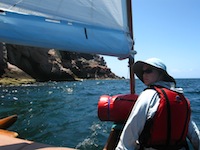 5th ~ Reef and bag it.
5th ~ Reef and bag it.
A lazybag (our word for lazyjacks + sailbag) serves as boom, sailbag, reefing method, mast rotation control, and vang. The bag is at boom height; it is soft, it’s never going to conk you like a normal boom. The mainsail is raised, reefed, and lowered from above head height; it’s a huge sail in a small boat but it’s never in the way, and you can see under it to where you’re going while bagging it. The canoe tri has lots of sail and not a lot of stability when sailed without an active crew. Reefing easily in rough water is the whole deal, the difference between enjoyable and scary. Being able to bag the whole 150 sq. ft. of main in about 15 seconds makes sailing into narrow areas with the wind behind, a sport.
6th ~ Cartop
Mast, floats, and crossarm nestle in a slim rocket shape, the canoe has a rocket nose cone,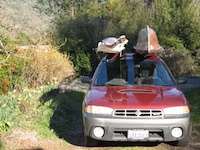 yet both have a flat side that fits naturally on a car
rack. Seen from the front it all has a very small profile.
Seen from the side it may seem a little daunting due to large overhangs
of a small car. If we hadn’t been doing it for 30 years we might feel
the same. The thing is to put that concern into a good job of tying on
and flagging. If it takes awhile it is still going to be, overall,
safer and less hassle than trailering.
yet both have a flat side that fits naturally on a car
rack. Seen from the front it all has a very small profile.
Seen from the side it may seem a little daunting due to large overhangs
of a small car. If we hadn’t been doing it for 30 years we might feel
the same. The thing is to put that concern into a good job of tying on
and flagging. If it takes awhile it is still going to be, overall,
safer and less hassle than trailering.
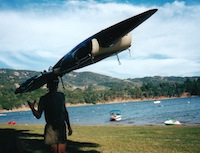 7th ~ Portage
7th ~ Portage
The trimaran assembles from components that are made to carry, with padding and straps and balance. It’s like portaging 2 normal canoes, 3 if you count the rig and gear. Our experience is that carrying the boat across a beach or over a footpath is fun, an excellent muscular stunt that complements the day. We stay strong to do it.
8th ~ The spirit
Old, fine redwood is the core of every component, thin strips covered by clear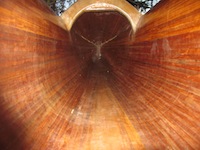 glass/epoxy on both sides,
something at first seeming delicate turning out
to be very tough. It’s mostly hand built because no machine is good at it,
and it takes a ton of hours and a million arm movements.
The canoe tri has the raptor look of the great trimarans of ocean racing.
Maybe sailing this boat on a lake feels like sailing a 100 footer on the
Southern Ocean.
Maybe the person has the spirit, who transports and sails this much boat
without so much fuss as a big car, trailer, boat ramp, and motor.
glass/epoxy on both sides,
something at first seeming delicate turning out
to be very tough. It’s mostly hand built because no machine is good at it,
and it takes a ton of hours and a million arm movements.
The canoe tri has the raptor look of the great trimarans of ocean racing.
Maybe sailing this boat on a lake feels like sailing a 100 footer on the
Southern Ocean.
Maybe the person has the spirit, who transports and sails this much boat
without so much fuss as a big car, trailer, boat ramp, and motor.
Need for Speed, of the right kind!
This boat is light, slender, and has lots of sail, but it is NOT terribly fast. Fast is wet, expensive, and complicated, which we suppose can be managed. But worst of all fast is heavy (in a rough interface). A canoe tri moves very well in light and medium air, but it is not meant nor rigged for going fast in heavy air. To do so it would have to be heavier and that is unacceptable, or highly engineered from space age materials and that is not needed. It is certainly meant to be used in heavy air, by reefing early and lot.
The boat is meant to be fast where it counts: to transport and assemble, and when the wind is light. The rest will take care of itself. It feels fast to take it from cartop and set it up because it is hard and dramatic, taking one’s mind off time. The curved and tapered 17 pound mast is raised by hand, like stringing a powerful bow.
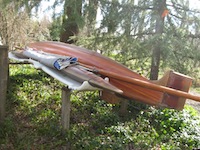 The boat is fast to fit into a life, by storing in a small space
(compared to a truly fast boat). It may hopefully store out of everyone’s
way, even on shelves “around back somewhere”. It is meant to be fast to
pack up and leave for some exotic location, yet somehow small enough to just
leave at home, out of the way, if you don’t want to go now (you own it and not the reverse.)
The boat is fast to fit into a life, by storing in a small space
(compared to a truly fast boat). It may hopefully store out of everyone’s
way, even on shelves “around back somewhere”. It is meant to be fast to
pack up and leave for some exotic location, yet somehow small enough to just
leave at home, out of the way, if you don’t want to go now (you own it and not the reverse.)
Fast to make friends, that’s the idea. For instance the crossarm belongs entirely to the crew, no sails or controls are in the way. The crossarm is like a horse, wide enough to sit on and narrow enough to straddle. It has protrusions that act like stirrups.
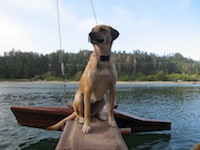
The boat is so wide (14’) that new crew quickly discover they have a lot of power to control their fate by moving their weight.
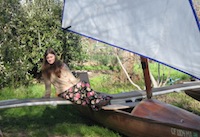
The crew is not crowded or blinded by the jib or unsettled by its flogging. This sail is not used upwind or in any stressful situation; it’s usually just an off-wind sail. It is spinnaker cloth and roller furls very tightly, and its sheets are out of the way.
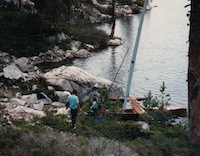
Crew can walk on board dry shod because a crossarm arches (almost always) to shore from a (usually) floating boat. They walk to the center, the float lifts, and off you go (with a few paddle shoves on the hard). Swimmers can get back on board by sinking a float with their weight. The crossarm becomes a ramp.
A Canoe Tri Asks,
“If there is sometimes no wind, often not enough, and occasionally too much, why not be good at all three?”
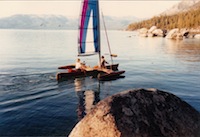
”No wind” is still a pleasure with chair-like seating, slender width (22” at the seat), and the artistry of paddling a single-blade. We have 20 years of rental history that says people like paddling trimarans and just forgetting the tippycanoe thing (and the drippy double blade).
Not enough wind means paddling and sailing together,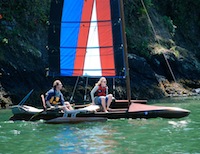 which is a plain good thing. The single blade’s asymmetry (that demands
J strokes in a canoe) changes to an advantage in a canoe tri. Paddling
on the lee side resists leeway, reduces drag, has a natural arm motion.
Paddling thru tacks means catching more wind and less frustration. If
you’re set up to quick-draw, hit some strokes, and stow the blade all
in few seconds, then why not?
which is a plain good thing. The single blade’s asymmetry (that demands
J strokes in a canoe) changes to an advantage in a canoe tri. Paddling
on the lee side resists leeway, reduces drag, has a natural arm motion.
Paddling thru tacks means catching more wind and less frustration. If
you’re set up to quick-draw, hit some strokes, and stow the blade all
in few seconds, then why not?
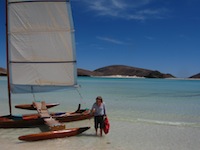
Not enough wind is pretty common in the canoe tri’s world, near shore and inland, so it has rather a lot of sail. More sail in square feet than the weight of the bare boat in pounds, which is rare. It would be more sensible to just paddle thru the light winds and only rig for the stronger, and forget the jib, but in this case we’re not sensible.
Too much wind means using the too-much-wind systems: four reefs in the main, a mast curve that flattens the sail as it gets smaller, mast raking that balances the helm when reefed, jib not needed (one sheet response to puffs). A canoe tri has a bow designed to spear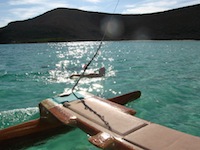 waves not be lifted, floats that can be pushed into waves and not be tripped.
It has significant crossarm buoyancy compared to trimarans that have two
spindly crossarms; this means that when the boat’s pushed partly over
and the float has no more reserve buoyancy, the crossarm still does,
and from an advantageous angle. You can feel it.
waves not be lifted, floats that can be pushed into waves and not be tripped.
It has significant crossarm buoyancy compared to trimarans that have two
spindly crossarms; this means that when the boat’s pushed partly over
and the float has no more reserve buoyancy, the crossarm still does,
and from an advantageous angle. You can feel it.
How could this ever be relaxing?
~ In the captain’s seat one reclines facing forward, like a car driver,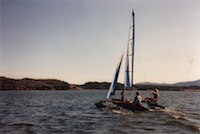 and sees the oncoming puff of wind as a dark pattern on the water without
moving one’s head. Just before the wind arrives the lee toe pulls,
the weather toe pushes, just a little bit, what a difference. The boat
turns into the wind precisely enough to let part of the force go by, then
away a bit to catch more of the last of it, and never heels at all. A new
crew only notices the water got bluer for a bit.
and sees the oncoming puff of wind as a dark pattern on the water without
moving one’s head. Just before the wind arrives the lee toe pulls,
the weather toe pushes, just a little bit, what a difference. The boat
turns into the wind precisely enough to let part of the force go by, then
away a bit to catch more of the last of it, and never heels at all. A new
crew only notices the water got bluer for a bit.
Reclining with extended legs, and feet gently inserted into the steering yoke so they can both push/pull, and meandering among wave sets and puffs, feels like easy skiing.
One quiet sail (fully battened) is used alone upwind,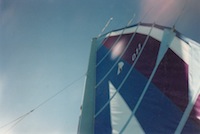 controlled by one
short line thru one big cleat, always right at one’s fingertips.
A puff might catch the sailor not paying attention but his hand is
always naturally so close to the mainsheet he is never unprepared.
The short sheet of the one-part system runs out so quickly that the
boat can duck any blow aimed at it.
controlled by one
short line thru one big cleat, always right at one’s fingertips.
A puff might catch the sailor not paying attention but his hand is
always naturally so close to the mainsheet he is never unprepared.
The short sheet of the one-part system runs out so quickly that the
boat can duck any blow aimed at it.
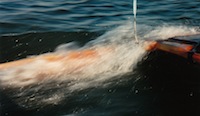
These outrigger floats have minimum buoyancy, compared to a beachcat or a real trimaran. Too much wind does not cause a sudden speed-up before a crash from high up. Instead the lee float and crossarm are pushed under and the boat will just slow down, in a good way, with a neutral helm.
What distinguishes this boat from similar craft? No other has these features:
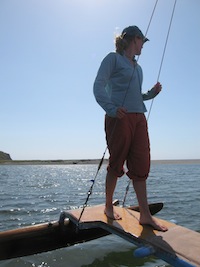
~ A single wide crossarm serves as crew seating, foam padded and fabric covered, a nicer-feeling surface than trampoline cloth and a more secure walking surface It has hand and foot holds, and a movable seat-back to recline against.
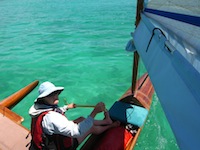 ~ The wide crossarm interferes less with paddling than two spindly crossarms do.
With crew sitting on it diagonally, they can keep their feet down in the boat
yet sit outboard and paddle without interference (or use the movable front seat).
~ The wide crossarm interferes less with paddling than two spindly crossarms do.
With crew sitting on it diagonally, they can keep their feet down in the boat
yet sit outboard and paddle without interference (or use the movable front seat).
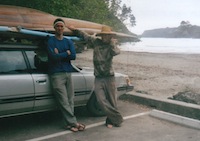
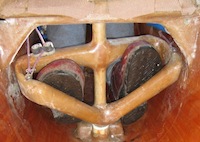 ~Steering by rotor, a device that allows both feet at once to power the rudder,
push-pull, and serves well to hold the captain in the boat. He could at any
moment lean far out to either side without handholds.
~Steering by rotor, a device that allows both feet at once to power the rudder,
push-pull, and serves well to hold the captain in the boat. He could at any
moment lean far out to either side without handholds.
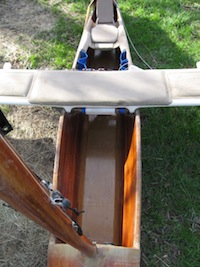
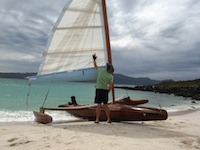
~Rapid and deep reefing, four reefs in the mainsail.
Most importantly: this reefing can be done by a solo sailor in rough water with the boat lying ahull (like it wants to) and without using miles of line. The new clew is hooked by use of an 8 foot wand stored inside the lazybag. Reefing takes 20-45 seconds. Bagging the sail entirely takes 15 seconds and leaves it secure and out of the way (that’s 150 sq. ft. of big roach, flat top main, and you can see where you’re going while you’re doing it.)
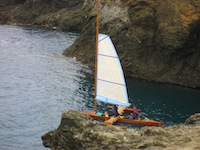 ~ The top half of the mast curves gradually more forward, so at full hoist
the sail has full camber, at fully reefed it is flat, without camber controls.
This means less fully crewed top
end speed and more simple/light/controllable.
~ The top half of the mast curves gradually more forward, so at full hoist
the sail has full camber, at fully reefed it is flat, without camber controls.
This means less fully crewed top
end speed and more simple/light/controllable.
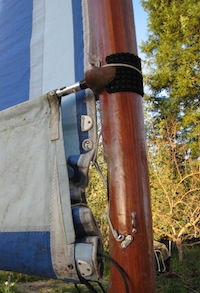
~ The lazybag serves as mast rotation control because the twin tubes at its upper edges push and pull at their off-center mast connections, as needed. The mast stays in line (more or less) with the sail as it is raised or lowered, and tacked.
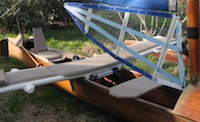
A sailboat without a traveler needs a vang; the lazybag’s shape makes it act like one. A small triangular sail acts as a more serious vang when desired and makes up the downside of such a high sail foot.
~ Reefing and crew weight change the helm, but this boat easily fine tunes the helm in
any conditions by raking the mast fore and aft with controls led to the captain’s seat.
Raking forward makes light air downwind a pleasure by keeping the main well out to the
side just by gravity.
Sailing alone often means sailing with a slight heel, a half-submerged lee float.
The mast can be canted to windward to compensate, with controls (of course) at hand.
Canting gives a little more lift upwind and a more balanced thrust downwind, and
makes raising the mast and sail easier.
but this boat easily fine tunes the helm in
any conditions by raking the mast fore and aft with controls led to the captain’s seat.
Raking forward makes light air downwind a pleasure by keeping the main well out to the
side just by gravity.
Sailing alone often means sailing with a slight heel, a half-submerged lee float.
The mast can be canted to windward to compensate, with controls (of course) at hand.
Canting gives a little more lift upwind and a more balanced thrust downwind, and
makes raising the mast and sail easier.
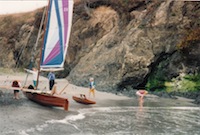
~ Portage and cartop. No other boat with room for 6 people comes anywhere close to the ease with which one person can carry this one over rough ground and set it up. No other matches this ratio of small cartop silhouette to large useable space.
~ Captain’s chair with all positions including “not used at all” and “taken ashore for a beach chair,” also seals the open area behind the captain if the boat is to be hit by waves from behind. Doesn’t interfere with paddling or holstering the paddle.
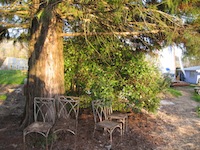 Why redwood? (We are currently recycling an old barn, and growing redwood trees, including this Sierra Big Tree).
Why redwood? (We are currently recycling an old barn, and growing redwood trees, including this Sierra Big Tree).
Can you believe we planted this as a little sprout?
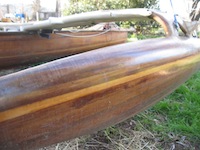 ~We’ve built over a hundred boats of redwood and glass; some are thirty years old.
Many have been treated very roughly in the rental trade. They hold up fine because
of redwood’s two remarkable qualities: it can have its coating broken and be exposed
to water and yet hold up month after month like no other lightweight wood, and
has high crushing strength compared to other woods, by weight. Redwood, epoxy, and
fiberglas yield a light and beautiful boat, durable and easily repaired.
The repair is never going to look like new, though, kind of like a birthmark.
~We’ve built over a hundred boats of redwood and glass; some are thirty years old.
Many have been treated very roughly in the rental trade. They hold up fine because
of redwood’s two remarkable qualities: it can have its coating broken and be exposed
to water and yet hold up month after month like no other lightweight wood, and
has high crushing strength compared to other woods, by weight. Redwood, epoxy, and
fiberglas yield a light and beautiful boat, durable and easily repaired.
The repair is never going to look like new, though, kind of like a birthmark.
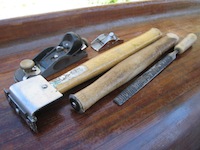
We use wood/fiberglas because it is so easy to build some new idea, a “one off” from an inexpensive new mold and test it out, and probably cut it up and put it together differently. We use hand tools most of the time, because green (partially cured) fiberglas is a pleasure to shape with woodworking h and tools and about impossible with power.
Why open canoe? What about big waves?
~It’s open because the advantages of open canoe happen every day and the disadvantages very rarely. In our 30 year 19 boat history waves have swamped a canoe tri about 6 times, usually in surf, among thousands of times when they might have, and we’ve learned something.
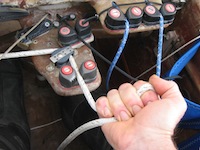
And getting tipped over, the multihull bugaboo? With canoe tri we make a choice to accept modest speed in upper wind ranges. It’s a kind of stability that doesn’t add cost or weight but is real nonetheless: the boat sails quite level almost all the time. But so, what if it doesn’t?
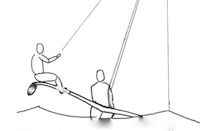
~This drawing does NOT illustrate normal sailing, this is the third stage of getting hammered. First is not seeing and steering toward, or away from, the puff, second is letting the float go under without letting out a bit of sheet. When the crossarm does go under it really gets your attention.
Why not a bigger float like a real trimaran? It would demand a stronger crossarm, beefier connections, etc. But it isn’t just weight and expense issues, it’s the kind of thinking going on here. Fast and powerful are only useful occasionally, when there’s just the right amount of wind. Too little and you’re just carrying hardware around, too much and it’s dangerous. A powerful sailboat can handle big wind with big sails by flattening and twisting, not reefing, but then comes the jibe. The inshore wind is very squirrelly.
We say, of the 24 hours of an average day on protected water, the over-canvased, under-rigged, paddling canoe tri will be the most appropriate boat 20 of those hours and just fine the rest.
This drawing is of the point at which the boat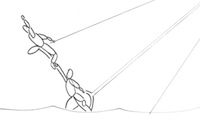 likes to hang if it’s really pasted.
It’s spilled the wind and not yet taking on water, the captain is still secure and in
position to save the day, and always does. The crew is standing on foot pegs and
holding rigging made to be held.
likes to hang if it’s really pasted.
It’s spilled the wind and not yet taking on water, the captain is still secure and in
position to save the day, and always does. The crew is standing on foot pegs and
holding rigging made to be held.
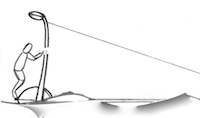
A sinking crossarm slows the boat down and lowers the crew towards the water rather than throwing them at it. They have time and handholds to rotate around.
If the mast hits the water the lee float and crossarm will have been submerged. This is
good, it keeps the mast level. There’s no turning turtle, the mast is sealed and quite buoyant.
it keeps the mast level. There’s no turning turtle, the mast is sealed and quite buoyant.
If crew stands on the full length shoe keel and pulls back they can tip the boat back upright, full of water.
Then it’s sail or bail.
Sailing to shore full of water to deal with it is an option. Funny sailing, as the boat is quite stable side-to-side, not so much end-to-end. It’s like low gravity sailing, you tend to float up.
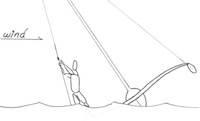
For many years the boat was fitted with a “venturi” bailer that used the speed of the boat to suck out water instead of bailing. We’ve come around to thinking, that like lot of boat gear, it is expensive, heavy, and not needed.
The plus side of open decks includes: twice as much useful space for the same weight, the luxury of one’s choice of postures and freedom of movement, the way they lay flat and solid o n the car rack. The front seat removes to increase access to the vast cargo space in front of the crossarm, and one wonders what might be stowed there. I consider it room for an adventurer to sleep, with gear stowed temporarily on the crossarm, at anchor on his minimal cruiser.
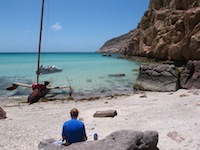
Our apologies for the unexplained sailing terms we’ve used here. It is too hard to speak succinctly without them, but we are very sorry to distance beginners from the story. Those new to sailing are in fact our chief interest, as those with a lot of experience too often have their minds already made up. This is a very high performance boat by a certain definition but it is not, not, not just for experts!
We need to mention also that most of these photos are for illustrating basic ideas, not showcasing perfect boats. These boats, and especially most of the sails, have succumbed to the force of new ideas and are recut, rebuilt, and reanimated. A new one would be an order of magnitude classier.
There are eight reasons for a Canoe Tri:

1st ~ To blend paddle and sail, because the water is a fascinating mix of wind and none. To do it without awkwardness, without wrestling a sail or shoving a paddle down among your other gear.

Start with the captain’s seat in the right place for both, so one sits high up and well braced to paddle yet has sail controls at one’s fingertips without moving. The paddle is in a “holster” just behind this seat. Quick-draw or re-holster in one quiet movement.

The mainsail is stored in a “lazybag” above sitting head height. It goes into action slower than a paddle but we claim to have made great improvement here.

The boat is steered by both feet, leaving both hands free to paddle and control sail. Those feet have a good hold and brace on the steering rotor, giving those hands all their native power for many tasks.
2nd reason ~ To fit one person like a glove, yet have seats for five and room for lots of stuff, canoe-like.
The captain’s space is built to keep him in the boat,
 though he is sitting sort of on top and it’s only two feet
wide. He is supported at hip, thigh and calf and his
feet have strong purchase. He can lean far over the side
and still feel secure, without hands. The chair reclines
and has a head rest. A very personal boat
though he is sitting sort of on top and it’s only two feet
wide. He is supported at hip, thigh and calf and his
feet have strong purchase. He can lean far over the side
and still feel secure, without hands. The chair reclines
and has a head rest. A very personal boat

It has another character completely, to be able to fill up the crossarm with people. The mast holds up the ends of the light crossarm when it is stressed this way. The canoe will sail satisfyingly well with 800 lbs aboard, not including its own 200 lb weight.
3rd ~ Paddle at 4 knots AND sail in the low teens.
A slender boat with 17” high well-padded seats and precise foot-steering should be fun to paddle. 225 sq. ft. of sail on a 24 ft. mast should sail fast. Neither is noteworthy by itself, though. Doing both is, and fits the world.
4th reason ~ Sail well in 9 inches of water and take the ground without fuss.
Excellent above-water features allow very modest underwater wings.
 A 2 inch deep shoe keel (with a big radius at its root) runs most of
the length and the rudder is no deeper than this keel. The rudder is hung
behind a bulletproof skeg and has tough wings on its bottom that make it act
deeper and bear weight. The rudder does not kick up, so it remains useful
even when getting knocked around, when it’s needed quite a bit.
There’s a lot of water in the world that is shallower than other boats prefer.
A 2 inch deep shoe keel (with a big radius at its root) runs most of
the length and the rudder is no deeper than this keel. The rudder is hung
behind a bulletproof skeg and has tough wings on its bottom that make it act
deeper and bear weight. The rudder does not kick up, so it remains useful
even when getting knocked around, when it’s needed quite a bit.
There’s a lot of water in the world that is shallower than other boats prefer.
 5th ~ Reef and bag it.
5th ~ Reef and bag it.
A lazybag (our word for lazyjacks + sailbag) serves as boom, sailbag, reefing method, mast rotation control, and vang. The bag is at boom height; it is soft, it’s never going to conk you like a normal boom. The mainsail is raised, reefed, and lowered from above head height; it’s a huge sail in a small boat but it’s never in the way, and you can see under it to where you’re going while bagging it. The canoe tri has lots of sail and not a lot of stability when sailed without an active crew. Reefing easily in rough water is the whole deal, the difference between enjoyable and scary. Being able to bag the whole 150 sq. ft. of main in about 15 seconds makes sailing into narrow areas with the wind behind, a sport.
6th ~ Cartop
Mast, floats, and crossarm nestle in a slim rocket shape, the canoe has a rocket nose cone,
 yet both have a flat side that fits naturally on a car
rack. Seen from the front it all has a very small profile.
Seen from the side it may seem a little daunting due to large overhangs
of a small car. If we hadn’t been doing it for 30 years we might feel
the same. The thing is to put that concern into a good job of tying on
and flagging. If it takes awhile it is still going to be, overall,
safer and less hassle than trailering.
yet both have a flat side that fits naturally on a car
rack. Seen from the front it all has a very small profile.
Seen from the side it may seem a little daunting due to large overhangs
of a small car. If we hadn’t been doing it for 30 years we might feel
the same. The thing is to put that concern into a good job of tying on
and flagging. If it takes awhile it is still going to be, overall,
safer and less hassle than trailering.
 7th ~ Portage
7th ~ Portage
The trimaran assembles from components that are made to carry, with padding and straps and balance. It’s like portaging 2 normal canoes, 3 if you count the rig and gear. Our experience is that carrying the boat across a beach or over a footpath is fun, an excellent muscular stunt that complements the day. We stay strong to do it.
8th ~ The spirit
Old, fine redwood is the core of every component, thin strips covered by clear
 glass/epoxy on both sides,
something at first seeming delicate turning out
to be very tough. It’s mostly hand built because no machine is good at it,
and it takes a ton of hours and a million arm movements.
The canoe tri has the raptor look of the great trimarans of ocean racing.
Maybe sailing this boat on a lake feels like sailing a 100 footer on the
Southern Ocean.
Maybe the person has the spirit, who transports and sails this much boat
without so much fuss as a big car, trailer, boat ramp, and motor.
glass/epoxy on both sides,
something at first seeming delicate turning out
to be very tough. It’s mostly hand built because no machine is good at it,
and it takes a ton of hours and a million arm movements.
The canoe tri has the raptor look of the great trimarans of ocean racing.
Maybe sailing this boat on a lake feels like sailing a 100 footer on the
Southern Ocean.
Maybe the person has the spirit, who transports and sails this much boat
without so much fuss as a big car, trailer, boat ramp, and motor.
Need for Speed, of the right kind!
This boat is light, slender, and has lots of sail, but it is NOT terribly fast. Fast is wet, expensive, and complicated, which we suppose can be managed. But worst of all fast is heavy (in a rough interface). A canoe tri moves very well in light and medium air, but it is not meant nor rigged for going fast in heavy air. To do so it would have to be heavier and that is unacceptable, or highly engineered from space age materials and that is not needed. It is certainly meant to be used in heavy air, by reefing early and lot.
The boat is meant to be fast where it counts: to transport and assemble, and when the wind is light. The rest will take care of itself. It feels fast to take it from cartop and set it up because it is hard and dramatic, taking one’s mind off time. The curved and tapered 17 pound mast is raised by hand, like stringing a powerful bow.
 The boat is fast to fit into a life, by storing in a small space
(compared to a truly fast boat). It may hopefully store out of everyone’s
way, even on shelves “around back somewhere”. It is meant to be fast to
pack up and leave for some exotic location, yet somehow small enough to just
leave at home, out of the way, if you don’t want to go now (you own it and not the reverse.)
The boat is fast to fit into a life, by storing in a small space
(compared to a truly fast boat). It may hopefully store out of everyone’s
way, even on shelves “around back somewhere”. It is meant to be fast to
pack up and leave for some exotic location, yet somehow small enough to just
leave at home, out of the way, if you don’t want to go now (you own it and not the reverse.)
Fast to make friends, that’s the idea. For instance the crossarm belongs entirely to the crew, no sails or controls are in the way. The crossarm is like a horse, wide enough to sit on and narrow enough to straddle. It has protrusions that act like stirrups.

The boat is so wide (14’) that new crew quickly discover they have a lot of power to control their fate by moving their weight.

The crew is not crowded or blinded by the jib or unsettled by its flogging. This sail is not used upwind or in any stressful situation; it’s usually just an off-wind sail. It is spinnaker cloth and roller furls very tightly, and its sheets are out of the way.

Crew can walk on board dry shod because a crossarm arches (almost always) to shore from a (usually) floating boat. They walk to the center, the float lifts, and off you go (with a few paddle shoves on the hard). Swimmers can get back on board by sinking a float with their weight. The crossarm becomes a ramp.
A Canoe Tri Asks,
“If there is sometimes no wind, often not enough, and occasionally too much, why not be good at all three?”

”No wind” is still a pleasure with chair-like seating, slender width (22” at the seat), and the artistry of paddling a single-blade. We have 20 years of rental history that says people like paddling trimarans and just forgetting the tippycanoe thing (and the drippy double blade).
Not enough wind means paddling and sailing together,
 which is a plain good thing. The single blade’s asymmetry (that demands
J strokes in a canoe) changes to an advantage in a canoe tri. Paddling
on the lee side resists leeway, reduces drag, has a natural arm motion.
Paddling thru tacks means catching more wind and less frustration. If
you’re set up to quick-draw, hit some strokes, and stow the blade all
in few seconds, then why not?
which is a plain good thing. The single blade’s asymmetry (that demands
J strokes in a canoe) changes to an advantage in a canoe tri. Paddling
on the lee side resists leeway, reduces drag, has a natural arm motion.
Paddling thru tacks means catching more wind and less frustration. If
you’re set up to quick-draw, hit some strokes, and stow the blade all
in few seconds, then why not?

Not enough wind is pretty common in the canoe tri’s world, near shore and inland, so it has rather a lot of sail. More sail in square feet than the weight of the bare boat in pounds, which is rare. It would be more sensible to just paddle thru the light winds and only rig for the stronger, and forget the jib, but in this case we’re not sensible.
Too much wind means using the too-much-wind systems: four reefs in the main, a mast curve that flattens the sail as it gets smaller, mast raking that balances the helm when reefed, jib not needed (one sheet response to puffs). A canoe tri has a bow designed to spear
 waves not be lifted, floats that can be pushed into waves and not be tripped.
It has significant crossarm buoyancy compared to trimarans that have two
spindly crossarms; this means that when the boat’s pushed partly over
and the float has no more reserve buoyancy, the crossarm still does,
and from an advantageous angle. You can feel it.
waves not be lifted, floats that can be pushed into waves and not be tripped.
It has significant crossarm buoyancy compared to trimarans that have two
spindly crossarms; this means that when the boat’s pushed partly over
and the float has no more reserve buoyancy, the crossarm still does,
and from an advantageous angle. You can feel it.
How could this ever be relaxing?
~ In the captain’s seat one reclines facing forward, like a car driver,
 and sees the oncoming puff of wind as a dark pattern on the water without
moving one’s head. Just before the wind arrives the lee toe pulls,
the weather toe pushes, just a little bit, what a difference. The boat
turns into the wind precisely enough to let part of the force go by, then
away a bit to catch more of the last of it, and never heels at all. A new
crew only notices the water got bluer for a bit.
and sees the oncoming puff of wind as a dark pattern on the water without
moving one’s head. Just before the wind arrives the lee toe pulls,
the weather toe pushes, just a little bit, what a difference. The boat
turns into the wind precisely enough to let part of the force go by, then
away a bit to catch more of the last of it, and never heels at all. A new
crew only notices the water got bluer for a bit.
Reclining with extended legs, and feet gently inserted into the steering yoke so they can both push/pull, and meandering among wave sets and puffs, feels like easy skiing.
One quiet sail (fully battened) is used alone upwind,
 controlled by one
short line thru one big cleat, always right at one’s fingertips.
A puff might catch the sailor not paying attention but his hand is
always naturally so close to the mainsheet he is never unprepared.
The short sheet of the one-part system runs out so quickly that the
boat can duck any blow aimed at it.
controlled by one
short line thru one big cleat, always right at one’s fingertips.
A puff might catch the sailor not paying attention but his hand is
always naturally so close to the mainsheet he is never unprepared.
The short sheet of the one-part system runs out so quickly that the
boat can duck any blow aimed at it.

These outrigger floats have minimum buoyancy, compared to a beachcat or a real trimaran. Too much wind does not cause a sudden speed-up before a crash from high up. Instead the lee float and crossarm are pushed under and the boat will just slow down, in a good way, with a neutral helm.
What distinguishes this boat from similar craft? No other has these features:

~ A single wide crossarm serves as crew seating, foam padded and fabric covered, a nicer-feeling surface than trampoline cloth and a more secure walking surface It has hand and foot holds, and a movable seat-back to recline against.
 ~ The wide crossarm interferes less with paddling than two spindly crossarms do.
With crew sitting on it diagonally, they can keep their feet down in the boat
yet sit outboard and paddle without interference (or use the movable front seat).
~ The wide crossarm interferes less with paddling than two spindly crossarms do.
With crew sitting on it diagonally, they can keep their feet down in the boat
yet sit outboard and paddle without interference (or use the movable front seat).

The crossarm holds floats
and mast in its curves for a
sleek cartop shape.
 ~Steering by rotor, a device that allows both feet at once to power the rudder,
push-pull, and serves well to hold the captain in the boat. He could at any
moment lean far out to either side without handholds.
~Steering by rotor, a device that allows both feet at once to power the rudder,
push-pull, and serves well to hold the captain in the boat. He could at any
moment lean far out to either side without handholds.

~Open canoe, only part decked. The freedom to
move around in it and put a lot of stuff in it.

~Rapid and deep reefing, four reefs in the mainsail.
Most importantly: this reefing can be done by a solo sailor in rough water with the boat lying ahull (like it wants to) and without using miles of line. The new clew is hooked by use of an 8 foot wand stored inside the lazybag. Reefing takes 20-45 seconds. Bagging the sail entirely takes 15 seconds and leaves it secure and out of the way (that’s 150 sq. ft. of big roach, flat top main, and you can see where you’re going while you’re doing it.)
 ~ The top half of the mast curves gradually more forward, so at full hoist
the sail has full camber, at fully reefed it is flat, without camber controls.
This means less fully crewed top
end speed and more simple/light/controllable.
~ The top half of the mast curves gradually more forward, so at full hoist
the sail has full camber, at fully reefed it is flat, without camber controls.
This means less fully crewed top
end speed and more simple/light/controllable.

~ The lazybag serves as mast rotation control because the twin tubes at its upper edges push and pull at their off-center mast connections, as needed. The mast stays in line (more or less) with the sail as it is raised or lowered, and tacked.

A sailboat without a traveler needs a vang; the lazybag’s shape makes it act like one. A small triangular sail acts as a more serious vang when desired and makes up the downside of such a high sail foot.
~ Reefing and crew weight change the helm,
 but this boat easily fine tunes the helm in
any conditions by raking the mast fore and aft with controls led to the captain’s seat.
Raking forward makes light air downwind a pleasure by keeping the main well out to the
side just by gravity.
Sailing alone often means sailing with a slight heel, a half-submerged lee float.
The mast can be canted to windward to compensate, with controls (of course) at hand.
Canting gives a little more lift upwind and a more balanced thrust downwind, and
makes raising the mast and sail easier.
but this boat easily fine tunes the helm in
any conditions by raking the mast fore and aft with controls led to the captain’s seat.
Raking forward makes light air downwind a pleasure by keeping the main well out to the
side just by gravity.
Sailing alone often means sailing with a slight heel, a half-submerged lee float.
The mast can be canted to windward to compensate, with controls (of course) at hand.
Canting gives a little more lift upwind and a more balanced thrust downwind, and
makes raising the mast and sail easier.

~ Portage and cartop. No other boat with room for 6 people comes anywhere close to the ease with which one person can carry this one over rough ground and set it up. No other matches this ratio of small cartop silhouette to large useable space.
~ Captain’s chair with all positions including “not used at all” and “taken ashore for a beach chair,” also seals the open area behind the captain if the boat is to be hit by waves from behind. Doesn’t interfere with paddling or holstering the paddle.
 Why redwood? (We are currently recycling an old barn, and growing redwood trees, including this Sierra Big Tree).
Why redwood? (We are currently recycling an old barn, and growing redwood trees, including this Sierra Big Tree).
Can you believe we planted this as a little sprout?
 ~We’ve built over a hundred boats of redwood and glass; some are thirty years old.
Many have been treated very roughly in the rental trade. They hold up fine because
of redwood’s two remarkable qualities: it can have its coating broken and be exposed
to water and yet hold up month after month like no other lightweight wood, and
has high crushing strength compared to other woods, by weight. Redwood, epoxy, and
fiberglas yield a light and beautiful boat, durable and easily repaired.
The repair is never going to look like new, though, kind of like a birthmark.
~We’ve built over a hundred boats of redwood and glass; some are thirty years old.
Many have been treated very roughly in the rental trade. They hold up fine because
of redwood’s two remarkable qualities: it can have its coating broken and be exposed
to water and yet hold up month after month like no other lightweight wood, and
has high crushing strength compared to other woods, by weight. Redwood, epoxy, and
fiberglas yield a light and beautiful boat, durable and easily repaired.
The repair is never going to look like new, though, kind of like a birthmark.

We use wood/fiberglas because it is so easy to build some new idea, a “one off” from an inexpensive new mold and test it out, and probably cut it up and put it together differently. We use hand tools most of the time, because green (partially cured) fiberglas is a pleasure to shape with woodworking h and tools and about impossible with power.
Why open canoe? What about big waves?
~It’s open because the advantages of open canoe happen every day and the disadvantages very rarely. In our 30 year 19 boat history waves have swamped a canoe tri about 6 times, usually in surf, among thousands of times when they might have, and we’ve learned something.

A more common swamping comes from sailing error, meaning only one thing: the mainsheet wasn’t released in a big puff, and we’ve learned to make that go away, by “one sheet, one part, one big Harken cleat at one’s fingertips.” And both feet secure.
And getting tipped over, the multihull bugaboo? With canoe tri we make a choice to accept modest speed in upper wind ranges. It’s a kind of stability that doesn’t add cost or weight but is real nonetheless: the boat sails quite level almost all the time. But so, what if it doesn’t?

~This drawing does NOT illustrate normal sailing, this is the third stage of getting hammered. First is not seeing and steering toward, or away from, the puff, second is letting the float go under without letting out a bit of sheet. When the crossarm does go under it really gets your attention.
Why not a bigger float like a real trimaran? It would demand a stronger crossarm, beefier connections, etc. But it isn’t just weight and expense issues, it’s the kind of thinking going on here. Fast and powerful are only useful occasionally, when there’s just the right amount of wind. Too little and you’re just carrying hardware around, too much and it’s dangerous. A powerful sailboat can handle big wind with big sails by flattening and twisting, not reefing, but then comes the jibe. The inshore wind is very squirrelly.
We say, of the 24 hours of an average day on protected water, the over-canvased, under-rigged, paddling canoe tri will be the most appropriate boat 20 of those hours and just fine the rest.
This drawing is of the point at which the boat
 likes to hang if it’s really pasted.
It’s spilled the wind and not yet taking on water, the captain is still secure and in
position to save the day, and always does. The crew is standing on foot pegs and
holding rigging made to be held.
likes to hang if it’s really pasted.
It’s spilled the wind and not yet taking on water, the captain is still secure and in
position to save the day, and always does. The crew is standing on foot pegs and
holding rigging made to be held.

A sinking crossarm slows the boat down and lowers the crew towards the water rather than throwing them at it. They have time and handholds to rotate around.
If the mast hits the water the lee float and crossarm will have been submerged. This is
good,
 it keeps the mast level. There’s no turning turtle, the mast is sealed and quite buoyant.
it keeps the mast level. There’s no turning turtle, the mast is sealed and quite buoyant.
If crew stands on the full length shoe keel and pulls back they can tip the boat back upright, full of water.
Then it’s sail or bail.
Sailing to shore full of water to deal with it is an option. Funny sailing, as the boat is quite stable side-to-side, not so much end-to-end. It’s like low gravity sailing, you tend to float up.

But the boat can be bailed even if awash,
by crew weight sinking the windward float.
Half the water will pour out leaving enough
freeboard to bail the rest.
For many years the boat was fitted with a “venturi” bailer that used the speed of the boat to suck out water instead of bailing. We’ve come around to thinking, that like lot of boat gear, it is expensive, heavy, and not needed.
The plus side of open decks includes: twice as much useful space for the same weight, the luxury of one’s choice of postures and freedom of movement, the way they lay flat and solid o n the car rack. The front seat removes to increase access to the vast cargo space in front of the crossarm, and one wonders what might be stowed there. I consider it room for an adventurer to sleep, with gear stowed temporarily on the crossarm, at anchor on his minimal cruiser.

Our apologies for the unexplained sailing terms we’ve used here. It is too hard to speak succinctly without them, but we are very sorry to distance beginners from the story. Those new to sailing are in fact our chief interest, as those with a lot of experience too often have their minds already made up. This is a very high performance boat by a certain definition but it is not, not, not just for experts!
We need to mention also that most of these photos are for illustrating basic ideas, not showcasing perfect boats. These boats, and especially most of the sails, have succumbed to the force of new ideas and are recut, rebuilt, and reanimated. A new one would be an order of magnitude classier.
